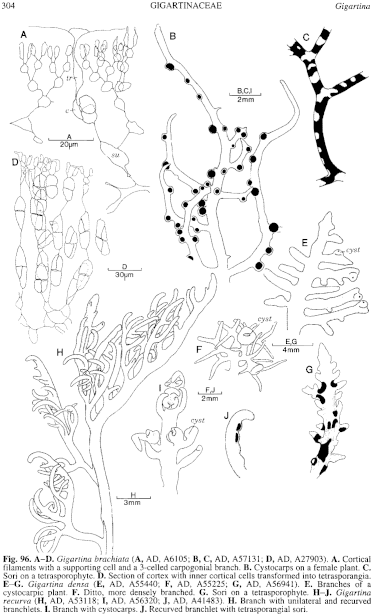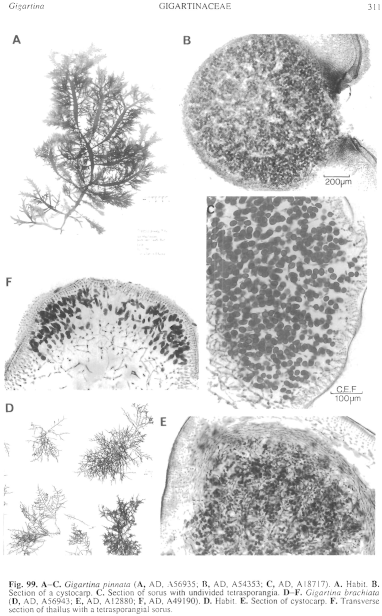|
|
|
|
|
|||||||||||
|
Electronic Flora of South Australia Species Fact Sheet
Phylum Rhodophyta – Class Florideophyceae – Order Gigartinales – Family Gigartinaceae
Synonyms
Fucus corniculatus R. Brown ex Turner 1811: 112, pl. 182 [NON F. corniculatus Wulfen in Jacquin 1787: 358; Wulfen 1803: 521. Several references refer to this species as a Gracilaria, but the type specimen is a Gigartina (see May 1948, p. 59).
Gigartina binderi Harvey 1863, synop.: xliv. J. Agardh 1876: 191. Setchell & Gardner 1933: 294.
Gigartina aciculifera Zanardini 1874: 502. J. Agardh 1876: 205. Millar & Kraft 1993: 16(?). Setchell & Gardner 1933: 294; 1934: 135 (as G. aculeifera, the name on the type sheet but not the published name).
Gigartina acicularis var. pinnata Hooker & Harvey 1847: 407.
Thallus (Fig. 99D) red-brown, fading to yellow-red, forming somewhat entangled clumps 5–8 cm high and 4–10 cm across, some fronds more or less erect and subpinnate in plants from moderate water movement, more irregularly branched and often subdichotomous below in calmer water plants; axes and larger branches compressed, (0.2–) 0.3–1 (–1.5) mm broad, laterals linear, terete to compressed, 0.3–0.5 mm broad, slightly basally constricted and tapering to acute, often bifid or nitid, curved apices. Holdfast discoid, 0.5–1 mm across, with occasional secondary haptera from branch ends; epilithic or rarely on Posidonia. Structure of a dense cortex of anticlinal, subdichotomous filaments, with ovoid inner cells 8–15 µm in diameter and end cells 2–3 µm in diameter and LID 2–3, and a medulla of relatively broad, mainly longitudinal, filaments 4–10 µm in diameter, anastomosing by means of lateral cells, forming a more irregular network in the outer medulla.
Reproduction: Sexual thalli monoecious. Carpogonial branches (Fig. 96A) 3-celled, situated on an inner cortical (supporting) cell near the apices of branchlets. Cystocarps (Fig. 96B) 0.8–1 mm across, usually single and protruding with the apex of the branchlet spinous, without involucral pinnules; carposporophyte (Fig. 99E) surrounded by moderate enveloping tissue without transverse filaments from the gonimoblast, and with a filamentous matrix of scattered larger cells (with thicker pit-connections) and clusters of ovoid carposporangia each 7–12 [im in diameter. Spermatangial sori occur as scattered patches, initials elongate, cutting off apically ovoid spermatangia 1–2 in diameter.
Tetrasporangial son (Fig. 96C) ovate to elongate or annular on lesser or main branches, each 0.8–1 mm broad; tetrasporangia (Fig. 96D) derived only by transformation of rows of inner cortical and outer medullary cells (Fig. 99F) which swell and separate, elongate-ovoid, 20–32 µm long and 8–14 µm in diameter, decussately cruciately divided.
Type from Georgetown, Tas. (Harvey); lectotype in TCD (Harvey, Alg. Aust. Exsicc. No. 397J). Isolectotypes (2) in NSW and in MEL, 652036, 652037.
Selected specimens: Sleaford Bay, S. Aust., in shaded eulittoral pool (Womersley, 22.ii.1959; AD, A22496). Billy Lights Point, Port Lincoln, S. Aust., uppermost sublittoral (Warnersley, 12.i.1984; AD, A55226). Edithburg, S. Aust., 0–1 m deep (Womersley, 18.ix.1981; AD, A52997). Off St Kilda, S. Aust., 1.5 m deep on Posidonia australis (S. Lewis, 23.viii.1972; AD, A42721). Glenelg, S. Aust., 4 m deep on "blocks" (Branden, 18.vi.1986; AD, A57131). Grange, S. Aust., drift (Gordon-Mills, 2.iv.1986; AD, A57060). Redbanks, Kangaroo I., S. Aust., low eulittoral (Womersley, 28.xii.1949; AD, Al2880). E side of Ballast Head, Kangaroo L, S. Aust., lower eulittoral (Womersley, 31,x.1947; AD, A6105). Pelican Lagoon, Kangaroo I., S. Aust., 3–4 m deep in channel (Womersley, 7.i.1990; AD, A60112). Blackfellows Caves, S. Aust., at low tide level (Edyvane, 20.xi.1984; AD, A56928; 13.viii.1984; AD, A56943; and Womersley, 8.xii.1991; AD, A61537 -"Marine Algae of southern Australia" No. 368). Williamstown, Vic., 1 m deep (Macpherson, 17.i.1960; AD, A24646). Wineglass Bay, Tas., rock pools (Wollaston & Mitchell, 2.iii.1964; AD, A27903). Swansea, Tas., lower eulittoral (Skinner, 22.ii.1978; AD, A49190). Dover, Tas., just sublittoral (Wollaston & Mitchell, 27.ii.1964; AD, A27726). Sydney, N.S.W. (MEL, 652034).
Distribution: Sleaford Bay, S. Aust., to Sydney, N.S.W., and around Tasmania, in the lower eulittoral or just sublittoral, usually in moderate to relatively sheltered localities.
Taxonomic notes: The earliest name given to this taxon is Fucus corniculatus R. Brown ex Turner (1811, pl. 182) from Kent Is, Bass Strait (Brown), but this is pre-dated by F. corniculatus Wulfen in Jacquin (1787, p. 358), soon recognised by Wulfen as a form of F. ericoides (Cystoseira). The next earliest name is Gigartina brachiata Harvey (1860a), and G. binderi Harvey (1863: synop. p. xliv) from Hobart, Tas., (lectotype in Herb. Harvey, TCD, probable isolectotypes in MEL, 652027, 652028) and G. aciculifera (aculeifera) Zanardini (1874, p. 502) also from Hobart, Tas., are considered synonyms.
An earlier name is Chondroclonium nigritum Kützing (1849, p. 740), from Tasmania, which however was described as "structure perenchymatica". Kützing (1867, p. 20, pl. 67a, b) later illustrated this species, but his illustration corresponds to a specimen now under Gigartina nigritum (in L, 941, 45 ... 63) of Hohenacker from 'Chiloe', dated 1860, and thus is not to be associated with the type (which has not been located in L). Kützing's illustration appears more like a Mychodea than a Gigartina. For the present, C. nigritum is regarded as a nomen dubium.
Fucus lividus Turner (1819, p. 140, pl. 254) has also been related to G. brachiata, but the former [" southern Ocean" (Menzies), almost certainly New Zealand] is a much broader, more pinnate species within the G. crassifolia group.
Gigartina brachiata has been recorded from New Zealand (Chapman 1979, p. 386) but the illustration of Chapman (pl. 168) is of a much broader and different species. G. chapmanii Hooker & Harvey in Harvey (1855b, p. 251, pl. 119B); Chapman (1979, p. 389, fig. 110, pl. 165) appears closely related to G. brachiata but differs in habit and is slenderer; however detailed comparisons are needed.
G. brachiata is distinguished by its clumped, entangled habit usually without percurrent axes, narrow compressed branches with subulate apices, the medulla of longitudinal, relatively broad, filaments with interlinking cells, and the tetrasporangial sori with tetrasporangia transformed from rows of 4–6 inner cortical and outer medullary cells, with none or few formed laterally. It is however variable in habit, with more pinnate branching in specimens subject to moderate water movement and more irregular (often terete) branching under sheltered conditions; the latter, especially in the Gulf region of South Australia, often show paler and darker banding or zoning of the branches.
References:
AGARDH, J.G. (1876). Species Genera et Ordines Algarum. Vol. 3, Part 1 - Epicrisis systematis Floridearum, pp. i-vii, 1–724. (Weigel: Leipzig.)
AGARDH, J.G. (1899). Analecta Algologica. Cont. V. Acta Univ. lund. 35, 1–160, Plates 1–3.
CHAPMAN, V.J. (1979). The marine algae of New Zealand. Part DI Rhodophyceae. Issue 4: Gigartinales. (Cramer: Germany.)
HARVEY, W.H. (1855b). Algae. In Hooker, J.D., The Botany of the Antarctic Voyage. II. Flora Novae-Zelandiae. Part II, pp. 211–266, Plates 107–121.
HARVEY, W.H. (1860a). Algae. In Hooker, J.D., The Botany of the Antarctic Voyage. 111. Flora Tasmaniae. Vol. II, pp. 321–343, Plates 185–196.
HARVEY, W.H. (1863). Phycologia Australica. Vol. 5, Plates 241–300, synop., pp. i-lxxiii. (Reeve: London.)
HOOKER, J.D. & HARVEY, W.H. (1847). Algae Tasmanicae. Lond. J. Bot. 6, 397–417.
JACQUIN, N.J. (1787). Collectanea ad botanicam, chemiam, et historiam naturalem spectantia, cum figuris. Vol. 1, pp. 1–386, Plates 1–22. (Wien.)
KÜTZING, F.T. (1849). Species Algarum. (Leipzig.)
KÜTZING, F.T. (1867). Tabulae Phycologicae. Vol. 17. (Nordhausen.)
MAY, V. (1948). The algal genus Gracilaria in Australia. C.S.I.R.O. Bull. 235. pp. 1–64, Plates 1–15.
MILLAR, A.J.K. & KRAFT, G.T. (1993). Catalogue of Marine and Freshwater Red Algae (Rhodophyta) of New South Wales, including Lord Howe Island, South-western Pacific. Aust. Syst. Bot. 6, 1–90.
SETCHELL, W.A. & GARDNER, N.L. (1933). A preliminary survey of Gigartina, with special reference to its Pacific North American species. Univ. Calif Pubis Bot. 17, 255–340.
SETCHELL, W.A. & GARDNER, N.L. (1934). De Gigartinis. Rev. Algol. 7, 131–138.
TURNER, D. (1811). Fuci sive Plantarum Fucorum Generi a Botanicis Ascriptarum Icones Descriptiones et Historia. Vol. 3, pp. 1–148, Plates 135–196. (London.)
TURNER, D. (1819). Fuci sive Plantarum Fucorum Generi a Botanicis Ascriptarum Icones Descriptiones et Historia. Vol. 4, pp. 1–153, Plates 197–258. (London.)
ZANARDINI, J. (1874). Phyceae Australicae novae vel minus cognitae. Flora (Regensburg) 57, 486–490, 497–505.
The Marine Benthic Flora of Southern Australia Part IIIA complete list of references.
Publication:
Womersley, H.B.S. (14 January, 1994)
The Marine Benthic Flora of Southern Australia
Rhodophyta. Part IIIA, Bangiophyceae and Florideophyceae (to Gigartinales)
Reproduced with permission from The Marine Benthic Flora of Southern Australia Part IIIA 1994, by H.B.S. Womersley. Australian Biological Resources Study, Canberra. Copyright Commonwealth of Australia.
Illustrations in Womersley Part IIIA, 1994: FIGS 96 A–D, 99 D–F.

Figure 96 enlarge
Fig. 96. A–D. Gigartina brachiata (A, AD, A6105; B, C, AD, A57131; D, AD, A27903). A. Cortical filaments with a supporting cell and a 3-celled carpogonial branch. B. Cystocarps on a female plant. C. Sori on a tetrasporophyte. D. Section of cortex with inner cortical cells transformed into tetrasporangia. E–G. Gigartina densa (E, AD, A55440; F, AD, A55225; G, AD, A56941). E. Branches of a cystocarpic plant. F. Ditto, more densely branched. G. Sori on a tetrasporophyte. H–J. Gigartina recurva (H, AD, A53118; I, AD, A56320; J, AD, A41483). H. Branch with unilateral and recurved branchlets. I. Branch with cystocarps. J. Recurved branchlet with tetrasporangial sori.

Figure 99 enlarge
Fig. 99. A–C. Gigartina pinnata (A, AD, A56935; B, AD, A54353; C, AD, A18717). A. Habit. B. Section of a cystocarp. C. Section of sorus with undivided tetrasporangia. D–F. Gigartina brachiata (D, AD, A56943; E, AD, Al2880; F, AD, A49190). D. Habit. E. Section of cystocarp. F. Transverse section of thallus with a tetrasporangial sorus.

|
Email Contact: State Herbarium of South Australia |

|